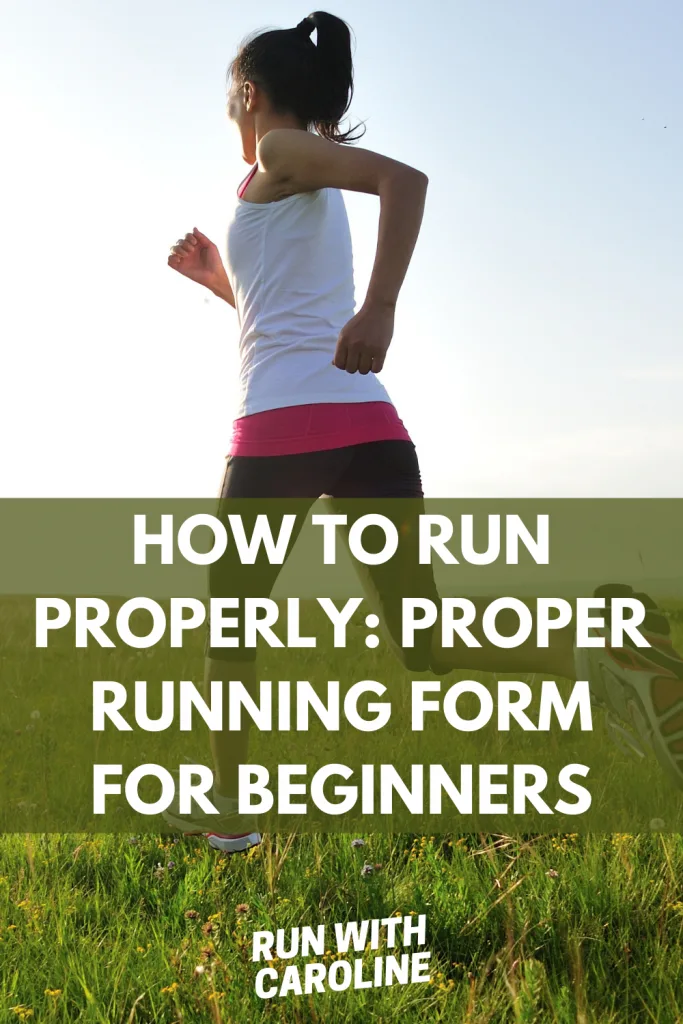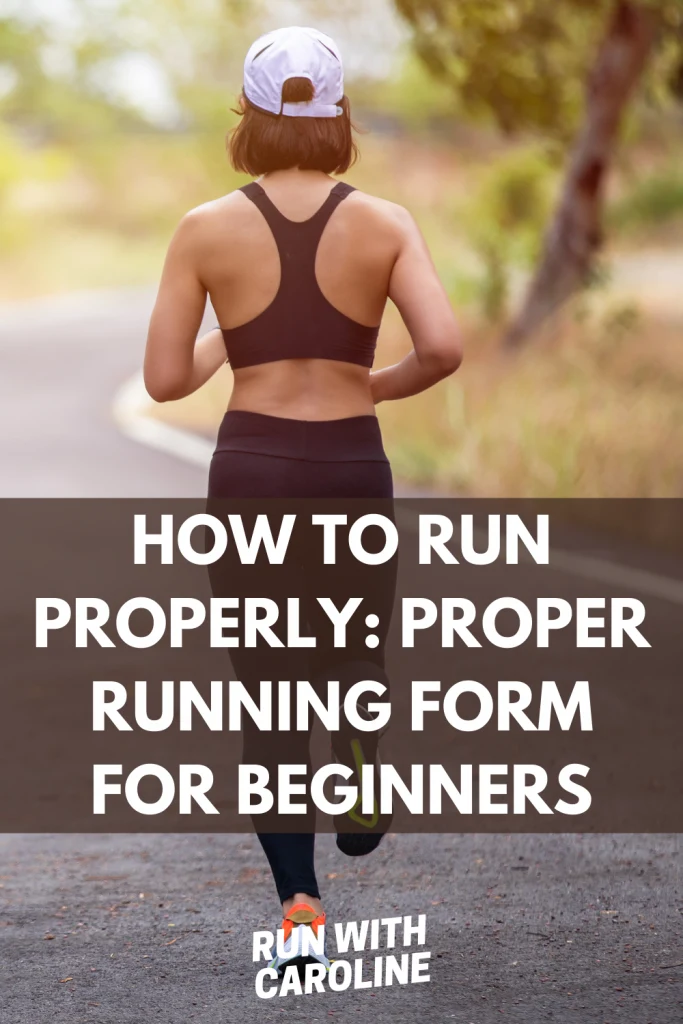If you want to want to learn how to run properly, the key is to give more thought to your running form and technique.
Many beginner runners don’t think about their form and technique when they first start running.
Whilst this is completely fine to begin with, over time as you increase your mileage, incorrect running form can cause muscle imbalances and put you at higher risk of injury.
Proper running form can take time to master and practice.
But it pays off in the long term to learn how to run properly and run with consistent good form.
So what actually constitutes proper running form and technique?
In this guide we’ll look at:
- What is proper running form?
- What are the benefits of proper running form?
- What are the key components of proper running form?
- How to run properly when jogging
- How to run properly when sprinting
- How to run properly on a treadmill
- Can I change my running form and technique?
- Tips to improve your running form and technique
Ready?
Let’s go!

What is proper running form?
In order to know how to run properly, you must first learn what proper running form actually is.
Proper running form and technique is all about running in the most efficient and economical way possible, placing as little stress as possible on your muscles and joints.
Many components work together to create optimal running form and technique, including your posture, arm swing, footstrike and cadence.
According to a 2017 study, running technique is a key component of running economy and performance.
In this guide, I’ll explain the 5 key components of running form.
Related: What is proper running form: 5 key principles of proper running form
What are the benefits of proper running form?
Proper running form and technique is important because it encourages better movement patterns and muscle recruitment when running.
This in turn will help you run more efficiently and reduce the risk of fatigue and overuse injuries like IT band syndrome and runner’s knee.
Running form and technique is particularly important for runners who run long distance or who run more frequently, think between 10 to 30 miles per week.
Here are the benefits of proper running form:
- Improves athletic performance
- Helps you run more efficiently
- Helps you run faster
- Reduces the risk of fatigue
- Reduces the risk of common running injuries like IT band syndrome and runner’s knee
- Helps you stay healthy as a runner
Related: 4 simple tips to improve running form

What are the key components of proper running form?
There are six key components of proper running form:
- Posture
- Arm swing
- Footstrike
- Cadence
- Core strength
- Breathing
Let’s take a look at each of these areas in more detail.
#1 Posture
Good posture involves you training your body to walk and run in a certain way.
Positions where the least strain is placed on joints, supporting muscles and ligaments during movement are best.
Good posture when running is key to ensure you don’t create imbalances in your muscles, which often lead to injuries.
For many of us, sitting behind a desk all day creates bad posture habits.
The tendency is to hunch over, lower your shoulders and head which doesn’t translate to good running form.
Here’s how to maximise your running form:
- Maintain a good posture and engage your core. Lean slightly forward, and hinged at the hips.
- Keep your gaze upright and avoid tilting your head down.
- Keep your chest lifted and draw your shoulders back and down (don’t hunch).
- Keep your arms relaxed and avoid crossing your arms in front of your body.
- Keep your knees soft and bent. Focus on lifting your knees forward, not upwards.
- Focus on landing on the middle of your foot.
- Aim to land your foot directly under your hips as you propel your body forward.
When I work with beginner runners, I ask them to imagine they have a helium balloon attached to their head with a piece of string.
They lift their chin and move their shoulders back. It’s amazing what these small changes can do to someone’s running form.
You’ll find that once you start to raise your hips, the other parts of your body, including your chest and shoulders, will also straighten up.
Related: 4 simple ways to improve your running form
#2 Arm swing
Although running predominantly uses your legs to power you through the run, your arms also play an important role.
How you hold and swing your arms makes a big difference to your stride and performance.
Good arm swing can help you run faster, more efficiently and even lower your risk of injury as well as help stabilise your body.
There is an easy way to see just how important your arm swing is and how it can affect your overall rhythm.
Run with your arms relaxed down by your sides.
You’ll notice that this creates additional work for your back, hips and legs and also makes running feel really uncomfortable!
Arm swing helps propel you forward (especially during faster runs) and lift your body off the ground with each stride.
The key is to keep your arms relaxed, by your sides and try and not let them cross your body.
If you let your arms cross your body too much, it will cause rotation in your spine and thorax and will create inefficient running form.
It may feel strange at first, but slowly but surely it will soon become second nature.
Related: Proper arm swing and 5 ways to improve it

#3 Footstrike
The way your foot hits the ground (also called ‘footstrike’) is important when it comes to good running form.
Your footstrike falls into one of three categories:
- Heel footstrike
- Forefoot footstrike
- Mid-foot footstrike
There isn’t a clear favourite in the running community, mainly because all three footstrike types can be used in different ways and on different terrains.
Many runners will also use all three footstrikes in one form or another throughout their running life.
This is partly due to the reasons stated above, and the fact that we all have different biomechanics (your body’s natural mechanisms).
Heel footstrike is probably the most common amongst runners. This is when your heel hits the ground first.
The mid-foot footstrike, when the middle part of your foot hits the ground first, is most the most preferred as it distributes your weight more evenly throughout the foot and ankle.
Related: Proper running footstrike and ways to improve it
#4 Cadence
Running cadence is probably one of the simplest things to master when it comes to proper running form.
Put simply, cadence – also known as stride rate – is the number of steps a runner takes per minute (SPM).
It plays an important role when it comes to proper running form, and has even been shown to reduce the risk of injury in runners.
If you have a low cadence, you will also likely have a long stride.
Over striding is when your foot lands in front of your body when running, and is often defined as any touchdown on the heel.
Runners who over stride tend to hit the ground with their heel first (also known as ‘heel strike’) and with more force, therefore putting extra pressure on their heels, knees, muscles and joints.
Over time this can lead to strain and injury.
The correct cadence varies amongst runners and depends on factors like height and weight of the runner.
Studies have shown, however, that a cadence of 170 SPM or higher is ideal for performance and injury prevention.
Related: 4 simple ways to improve running cadence
#5 Core strength
Your core is extremely important when running.
A good core means you are able to hold a strong and stable position for longer, thus allowing you hold proper form and posture.
Your back and stomach muscles are key components for good core strength.
Unfortunately, running alone won’t improve your core strength, you need to dabble in core strength exercises as well as running to really see results.
Related: 9 best core exercises for runners (and how to do them properly)
#6 Breathing
Breathing when running can be difficult when you think too much about it.
However, it is a lot easier to breathe deeply when you have good running form and posture.
You may have already heard of ‘belly breathing’. This is a breathing technique that involves taking deep breaths and using the diaphragm a lot more to draw more air into your lungs.
Many runners take short breaths and therefore under use their diaphragm.
When you take short breaths, you rely too much on your chest muscles and therefore take in less oxygen.
You also under use your intercostal muscles (the muscles in between your ribs) so they become smaller and quick to fatigue.
It’s important to strengthen these so they can fully support the breathing process.
To train yourself to breathe from your belly, practice belly breathing lying down, sitting down and standing up.
- Lie down on your back and keep your upper chest and shoulders still.
- Focus on raising your belly as you inhale, lower your belly as you exhale.
- Inhale and exhale through BOTH your nose and mouth.
General health advice out there is that you should breathe from your diaphragm at all times, whether you’re running, walking or sleeping.
If you practice yoga, you’re probably used to breathing deeply anyway.
Breathing deeply is a great way to relieve stress and anxiety symptoms, so what better way to start!
Related: How to breathe when running

How to run properly when jogging
Your running form when jogging won’t be the same as when you’re sprinting.
Whilst a lot of the same running form principles apply, you won’t be required to pump your arms or lift your knees as you’ll be running at a slower pace.
Here are some tips on how to run properly when jogging:
- Maintain a good posture
- Engage your core and keep your gaze upright
- Use a relaxed arm swing and avoid crossing your arms in front of your body
- Use a mid-foot strike where possible
Related: How to run faster and longer: 4 training secrets
How to run properly when sprinting
As discussed earlier, sprinting involves running at a faster pace, which means you need to make slight tweaks to your running form so you can run in the most efficient way possible.
Sprinting is an explosive movement, so you need to adopt a powerful stride during the run.
Here are some tips on how to run properly when sprinting:
- Lean slightly forward, engage your core
- Use short, fast strides
- Aim to land your foot softly and quietly with minimal impact force
- Use a forefoot strike to propel your body forward
- Bend your elbows at a 90 degree angle and pump them back and forth to propel your forward
- Avoid rotating your torso as you run
Related: What is sprint interval training? Benefits + 3 sample workouts
How to run properly on a treadmill
Running on a treadmill is a good option for many runners who are looking to add some variety into their training plan.
Treadmill running however has its own set of benefits and challenges.
One of the key benefits of running on a treadmill is that it forces you to use shorter strides since over striding will cause you to kick the front of the treadmill.
Here’s how to run properly on a treadmill:
- Lean slightly forward, engage your core
- Draw your shoulders back and maintain an erect spine
- Avoid looking down at the monitor, keep your gaze upright
- Use short strides
- Avoid hanging on the rails when you run
Related: The ultimate guide to running on a treadmill + 5 treadmill workouts
Can I change my running form and technique?
There are very few scenarios in which you should actively change your running form and technique.
After all, everyone runs differently and each runner has their own bio-mechanics and body structure which determines how they run.
Factors such as age, gender, weight and injury and medical history will all be determining factors in terms of how you run.
That said, there’s no harm in learning about how to run properly.
By practicing various running form drills and techniques, this will help you to implement small changes to improve your running form over time.
Related: The essential guide to head to toe running form and technique

How to improve your running form and technique
Now to know how to run properly and the key components of proper running form, here are the best ways to improve your form and technique:
#1 Practice running form drills
Running form drills are essentially dynamic exercises that help you develop proper running form and technique.
They also help to:
- Develop the technical skills and proper movement patterns needed for running.
- Strengthen the muscles and joints needed for strong, fast and less injury-prone running.
Drills can be done as part of a warm-up before a run, race or before a speed training session.
You can also do them as part of a standalone session if you really want to hone in on a particular technique or skill.
Aim to do running drills at least twice a week in order to reap the benefits.
As with most things running-related, the more consistent you are, the better the results will be.
When considering which running form drills to do, make sure they align with your specific goals and needs.
For example:
- If you struggle to lift your knees during a speed training session, focus on running form drills like high knees and carioca that get you into the habit of lifting your knees.
- If you suffer with lazy glutes, running form drills that target and activate the glutes like A-skips and straight-leg bounds will be beneficial for you to complete before a run.
Although you can choose to complete a variety of running form drills, they are much more effective when used to address certain movements or skills that you’d like to improve or work on.
Related: How to warm up before a run: 4 actionable tips
#2 Strength train
Strength training has many benefits for runners.
In fact, various studies have shown that when performed consistently, strength training (also known as resistance training) can benefit your running form and economy as well as help to reduce the risk of injury.
Aim to include 2 to 3 strength training sessions in your training plan each week. Each session doesn’t need to be longer than 30 minutes.
You can read more about strength exercises for runners in my strength training guide for runners.
#3 Wear the right running shoes
The right pair of running shoes will do wonders for your running form.
A good pair of running shoes will help to support your feet when running, cushion your feet from heavy landings, and protect against common running injuries like shin splints.
When finding the right pair of running shoes for you, it’s important to look at your gait. This is essentially how your feet behave when you run.
There are four types of gait to be aware of. You can find more information in my guide on how to find the right running shoes.
#4 Warm up and cool down
The warm up before a run and the cool down after a run will help to prevent muscle soreness and stiffness and reduce the risk of injury.
Muscle soreness and stiffness in can impact how you run.
Aim to do a warm up before each run to warm up and activate your muscles. You should include dynamic stretches as part of your warm up, as well as light jogging.
Aim to complete a cool down after each run bring your heart rate down. You should include static stretches in your cool down.
Related: The 9 best pre-run stretches (and how to do them properly)
More tips on running form and posture:
- The essential head to toe guide to running form and technique
- Proper arm swing and 5 ways to improve it
- 4 simple tips to improve running form
- 4 ways to improve running cadence
- Proper running footstrike and ways to improve it
- 5 things I wish I’d known before returning to running - March 3, 2024
- Running 20 minutes a day: Benefits + how to start - January 27, 2024
- How to run your first 2 hour half marathon - January 16, 2024

Steven Booth
Saturday 28th of November 2020
Good post. The only thing I would disagree with is knee lift. What you describe is what sprinters need rather than distance runners. The way I describe a correct running action is to drive back with your thigh muscles and let your foot fall back to the ground slightly in front landing on the front of your foot .. Landing on your heel is a no no, that's for walkers not runners. Pity your photo shows a heel striker.
Amy
Tuesday 31st of March 2020
Hey! Thanks so much for this post. I found it through Pinterest I believe. I applied it to my run today, and I really think it helped. And even though I don't know if it's why, I went even longer than I was supposed to run for—victory! So happy. I am a beginner runner, and I literally have only gone running twice now, but oh my goodness, I love it. It's hard, but I feel like it's something I can push myself in, and also just use what I know is in me towards something good. Thanks so much! Have a wonderful day, and if I find a subscribe button on your blog, I'll hit it. :) God bless. -Amy
Run With Caroline
Thursday 2nd of April 2020
Hi Amy! Glad you found my post useful! And even better you're now a runner! Congrats! I wish you all the best on your running journey :)